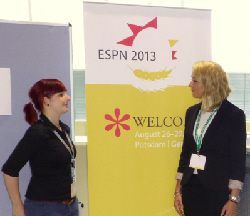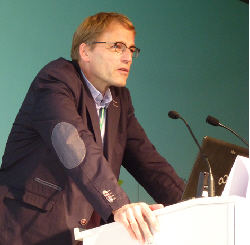



Poultry Nutrition Symposium: Old Questions Answered, New Ones Unveiled
The 19th European Symposium on Poultry Nutrition, which took place at the end of August, provided a forum for intense discussion between leading scientists and producers from around the world, reports Nottingham Trent University scientist, Emily Burton.
Three packed days of the Symposium were hosted by the World’s Poultry Science Association German Branch in Potsdam and attracted 686 delegates.
The symposium followed its well established tradition for interaction between audience and speakers through its unusual format. Each session started with three invited plenary presentations, after which the audience split into discussion groups to formulate questions for each speaker. The groups then rejoined for a plenary discussion where questions from each group were posed to the panel of speakers by the chair, who also encouraged further comments from the audience.
Searching for New Feed Ingredients
The first session saw three contrasting speakers covering developments in feed raw materials. Wolfgang Friedt, from the University of Gießen opened with a series of case studies on how plant breeding may improve the feeding value of plant feedstuffs.
Thomas van der Poel of Wageningen UR in the Netherlands explained how researchers are responding to the EU drive to reduce protein crop imports by evaluating unconventional raw materials for poultry feeding.
The audience was starkly reminded of the limited influence of the EU on the global grain market by the final speaker, Ludwig Striewe of Alfred C. Toepfer International, who outlined his projections for demand and production within global grain and protein markets until 2020.

The volume of questions directed at the first paper indicated the intense audience interest in the topic of plant breeding, but an early question challenged whether plant geneticists actually knew what poultry nutritionists wanted. Assurance was provided that plant breeders looked for direct data from animals to examine response to traits, but one audience member warned that performance as well as digestibility trials were needed as significant improvements in digestibility of a raw material were often lost when whole bird performance was subsequently assessed.
As discussion unfolded, it became clear from the speakers that to reduce imports of protein crops, the EU must both increase yield and better re-utilise materials already available, rather than solely relying on development of new protein sources. However, Dr Friedt warned that although modern tools greatly help, plant breeding is a slow process, taking around 10 years from identification of desirable trait to production of commercial cultivars.
At this point, the value of the shorter term solutions offered by Dr van der Poel became clearer, such as fractionation of peas to isolate their protein components efficiently. Many of the avenues explored in the first plenary discussion faced a major barrier to commercialisation in their production cost, as Striewe stated that international trade is bulk commodity business, where there is rarely capacity to segregate low volume, high value materials on intercontinental ships.
The low-cost requirement for food and feed crops was also cited by Dr Friedt as limiting long-term development of crops through plant breeding: while yield is the key market driver, it is not possible to deviate from selecting for yield to develop crops with other traits such as drought tolerance.
This point led to a question from the audience on what the impact of water scarcity might be on these areas. Dr Freidt answered that, as water scarcity will undoubtedly reduce the yield of current EU crops, it may become necessary to look at how tropical plants have evolved. Dr van der Poel added that some of the identified alternative protein sources which currently appear uneconomical may become more attractive alternatives in a drought situation. One audience member commented that the public are indeed likely to be keener on eating chicken that has been fed on insects than eating insects themselves.
Tropical plants are very efficient in their use of water, Dr Friedt explained, so there are two options for the EU to consider; growth of drought tolerant crops, such as sorghum, or isolation of genes coding for traits that could be transferred into current EU crops.
This concept instantly raised a question on the future of genetic modification in Europe. Several audience comments voiced the general feeling of frustration within the feed sector that, while use of genetically modified (GM) products is accepted in medicine, the EU insists plant-breeding remains GM-free. Dr Freidt also pointed out that, although new technologies are emerging in plant breeding, none are as powerful as GM. Quite simply, if a drought-tolerant gene does not exist in a crop, it cannot be selected for, so GM is necessary to create variation where none exists.
The impact of this legislative decision was also discussed in a global context, where it was concluded that we are likely to unwittingly import GM products as the GM-free sector becomes increasingly unimportant to the global market place. This possibility was reinforced by Dr Striewe, who had noted that new GM cultivars are being marketed with the statement ‘approved for use in all major US export countries’, demonstrating the EU is no longer perceived as a major export destination.
Sourcing Proteins
The second session continued to explore the challenges facing the poultry feed market through discussion of protein scarcity and utilisation. Frank Liebert from the University of Göttingen in Germany began by describing the currently available protein sources and promising developments to meet amino acid requirements.
This was followed by an explanation of new and established methods for the evaluation of protein and amino acids in differing raw materials by Olayiwola Adeola of Purdue University.
Henry Classen from the University of Saskatchewan rounded off the session by sharing his thoughts on the response of broiler chickens to dietary energy and its relationship to amino acid nutrition.
The session raised some interest in the possible role of proteases in managing the variability in protein quality of future feed materials, but it was concluded that more precision in defining which proteases maintain activity in the small intestine was vital before proteases become widely used.
Many of the audience questions relating to this session came back to the point that standardisation of methods was required for this research area to move forward.
The recent WPSA project standardising available phosphorus methodologies was cited as a possible model to follow for amino acid digestibility.
Feeding Strategies for Poultry
The second day of the symposium started with a session on feeding strategies. Once again, a diverse trio of speakers tackled the topic from a range of perspectives. Gonzalo Mateos from UP Madrid began by explaining the relevance of dietary fibre in feeding broilers and pullets.
This was followed by a well-illustrated talk from Sanna Steenfeldt of Aarhus University in Denmark on how to safeguard adequate nutrition in organic poultry production.

The final speaker of the session, Z. Zdunczyk from the Polish Academy of Sciences, neatly tied the two previous topics together through his discussion of gut health and efficiency via his talk on determinants and effects of post-ileal fermentation in the digestive tract of broilers and turkeys.
Intense discussion on the future of organic poultry production followed this session, with the Label Rouge concept cited as a success story. However, an audience member pointed out Label Rouge was not in fact organic, but drawing on the organic principle of creating a higher value product.
There was also strong audience interest in defining exactly what feed materials create optimum post-ileal fermentation but Dr Zdunczyk explained that so many variables affect post-ileal fermentation, making it is impossible to answer that question at this point in time, beyond Dr Mateos’ message of ensuring diets contained indigestible fibre.
Day two was rounded off by a new inclusion to the ESPN programme: the hot topics session.
Richard Ducatelle of Ghent University in Belgium opened by outlining recent findings on nutritional strategies for the control of necrotic enteritis, and in particular, explaining how a model had been developed at Ghent to consistently assess the efficacy of products in combating necrotic enteritis.
This was followed by an overview of management tools to reduce Footpad Dermatitis in broiler chickens from Ingrid de Jong from Wageningen UR in the Netherlands. Dr de Jong placed an unusual slant on her talk by including both economic and welfare measures in assessing viability of management strategies.
Dr Paul Hocking from University of Edinburgh then discussed whether nutrition can improve the welfare of commercial broiler breeders, and concluded that, while nutrition can ameliorate conditions a little, the situation could only be resolved through breeding strategies.

The Hot Topics session was concluded by an update from Markus Rodehutscord of the University of Hohenheim on the status of the WPSA Phosphorus sub-group. This group was formed by the Nutrition Working Group to address the issues surrounding inconsistencies in defining and measuring available phosphorus.
Professor Rodehutscord reported that the group had trawled the literature to produce a proposed methodology and definition for available phosphorus and submitted this for publication in the World’s Poultry Science Journal.
Factors Affecting Intake of Feed and Water
The first plenary theme of the final day was feed and water intake. Johan Buyse of KU Leuven discussed the commercial applicability of research examining quantitative feed restriction programmes for broiler chickens.
Josef Kamphues of the University of Veterinary Medicine, Hannover then comprehensively outlined key considerations surrounding quality of drinking water in poultry production before Loek de Lange of Schothorst Feed Research discussed factors affecting water intake and consequences of water deprivation, and application of additives via drinking water.
Questions on this session focussed on identifying situations creating risk to water quality, such as where water was stationary in warm pipes. There was also some clarification about whether water sanitizers posed a risk of reducing bird water intake – which an audience member categorically stated that they did not, if the usage guidelines were followed.
Feeding Layers
The final session of the symposium examined trends and perspectives in layer nutrition. Robert Pottgüter of Lohmann Tierzucht explained the nutritional challenges faced by birds housed in differing systems before Isabelle Bouvarel and Yves Nys of ITAVI Nouzilly, INRA outlined how egg mass and quality traits may be optimised in modern laying hens through nutrition.
Dr Pottgüter shared the view of Mateos given on the previous day highlighting the importance of indigestible fibre.
The final speaker, Ian Dunn from the Roslin Institute and University of Edinburgh communicated the initial findings of an ongoing project exploring options and limitations to extend the laying period.
Questions directed to Dr Pottgüter focussed on determining the impact of feed particle size and fibre delivery on both bird health and also ammonia production. Many questions for the final speaker centred on whether the traits currently being investigated in laying hens could be applied to broilers. Dunn agreed and also said that he believed that improving cuticle deposition on the eggs of broiler breeders represented a powerful aid in preventing vertical disease transmission in the broiler sector.
After three days of intense discussion, the symposium was closed by the Chair of the WPSA Working group, Sanna Steenfeldt, who thanked all those involved, and said she looked forward to welcoming everyone to the 20th Symposium to be held in Prague in two years time.
September 2013











